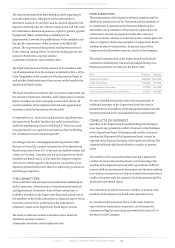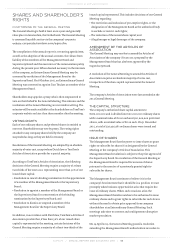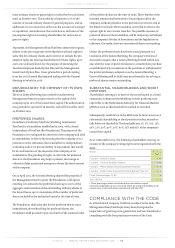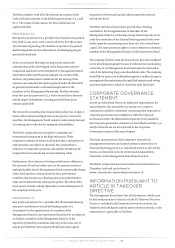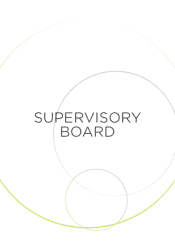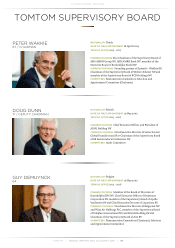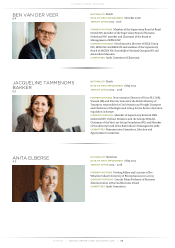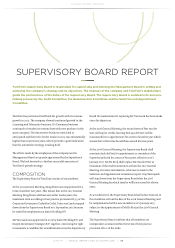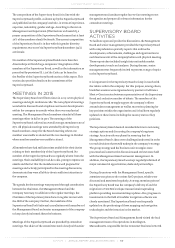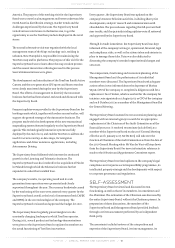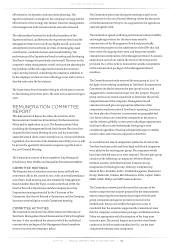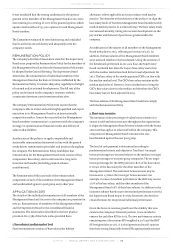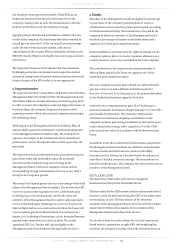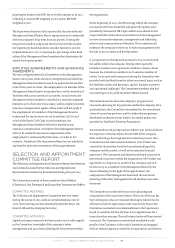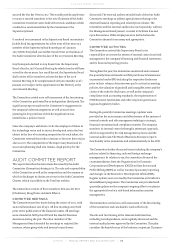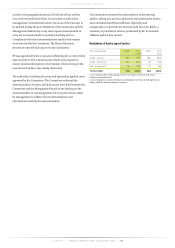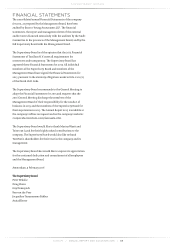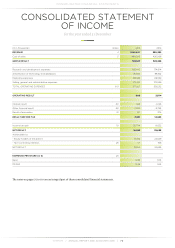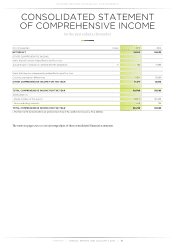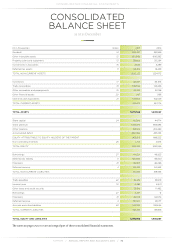TomTom 2015 Annual Report Download - page 63
Download and view the complete annual report
Please find page 63 of the 2015 TomTom annual report below. You can navigate through the pages in the report by either clicking on the pages listed below, or by using the keyword search tool below to find specific information within the annual report.
SUPERVISORY BOARD
TOMTOM / ANNUAL REPORT AND ACCOUNTS 2015 / 62
effectiveness, its dynamics and succession planning. The
Supervisory Board's oversight on the company's strategy and the
effectiveness of the strategy day, human resources management,
risk management and internal controls were also reviewed.
The relationships between the individual members of the
Supervisory Board, and between the Supervisory Board and the
Management Board were rated very highly overall, as was the
atmosphere in the boardroom in terms of encouraging equal
contribution, candid discussion and critical thinking. The
performance of the Supervisory Board in testing and developing
TomTom’s strategy was positively rated overall. The focus on the
company’s talent management as well as succession planning for
key positions within the organisation remain key attention
topics moving forward, considering the company’s ambition to
be the employer of choice in the technology sector and to attract,
develop and retain the best talents.
The Supervisory Board intends to bring in a third-party to assess
its functioning every three years; the next such occasion being in
2018.
REMUNERATION COMMITTEE
REPORT
This Remuneration Report describes the activities of the
Remuneration Committee (Committee), the Remuneration
Policy and its application in 2015. The Remuneration Policy
(including the Management Board Stock Option Plan) was first
adopted by the General Meeting in 2005 and has since been
amended several times, most recently in 2014. In line with Dutch
legislation, the execution of the Remuneration Policy in 2015 will
be put on the agenda for discussion as separate agenda item at
the 2016 General Meeting.
The Committee consists of three members: Guy Demuynck
(Chairman), Peter Wakkie and Jacqueline Tammenoms Bakker.
COMMITTEE MEETINGS
The Remuneration Committee met four times and held two
conference calls in the course of 2015, with an overall attendance
rate of 89%. Each meeting was also attended by Management
Board member Alain De Taeye, as well as the Head of HR, the
Head of Reward & Operations and the Company Secretary.
Preparation meetings attended by the Chairman of the
Committee, the Head of Reward & Operations and the Company
Secretary were held prior to each Committee meeting.
COMMITTEE ACTIVITIES
The Committee monitored the effectiveness and relevance of
TomTom's Management Board Remuneration Policy throughout
the year. It also considered the extent to which the individual
remuneration packages of the Management Board members
were in line with the company's policy.
The Committee spent time during its meeting in April on its
preparation for the 2015 General Meeting, where the execution
of the Remuneration Policy in 2014 appeared on the agenda as a
separate agenda item.
The Committee agreed on the key performance indicators (KPIs)
and weighting levels set for the short-term variable
remuneration of the Management Board and periodically
reviewed the progress on the achievement of the KPIs that had
been set for the ongoing short-term and long-term variable
remuneration components of the Management Board. A scenario
analysis was carried out within the terms of the best practice
provision II.2.1 of the Code to evaluate the variable components
of the remuneration packages of the Management Board
members.
The Committee previously assessed the peer group in 2013. In
the light of the evolving complexity in TomTom’s businesses the
Committee decided to reassess the peer group in 2015 and
engaged with a remuneration expert for this purpose. The peer
group serves as an essential yardstick to determine the overall
competitiveness of the company’s Management Board
remuneration and gives an appropriate reflection of the
competitive markets in which TomTom is operating. Less focus
has been placed in this years’ reassessment on geography and
size. Most relevant are considered companies in the same or
similar industry globally, as were peer technology organisations
with head offices in the Netherlands. Both groups were
considered regardless of having substantially larger or smaller
market values and revenues compared to TomTom.
As a result hereof, eleven competitors (reflective of each of the
TomTom business units) and three high-tech Dutch companies
were added to the existing peer group. The companies which
have been delisted since 2013 were removed. The new peer group
consists of the following 25 companies: Wolters Kluwer,
Harman, Garmin, ASM International, Temenos Group,
Imagination Technology Group, SimCorp, CompuGroup
Medical, Pace, Kudelski, GoPro, Trimble Navigation, Fleetmatics
Group, Elektrobit, Telenav, Mix Telematics, Fitbit, LoJack, Nokia
HERE, ASML, Philips and NXP Semiconductors.
The Committee reviewed and discussed the outcome of the
market competitiveness report prepared by the remuneration
expert comparing the remuneration packages with the peer
group companies and against prevalent practice in the
Netherlands, Europe and within the high-tech sector. It
concluded that the materials supported the Committee’s view
that the company’s remuneration packages and Remuneration
Policy are appropriate with the exception of the long-term
incentive plan. The annual long-term incentive award levels
continue to be below market median level i.e. are the least
competitive remuneration component.


